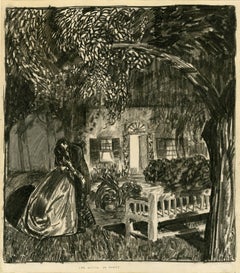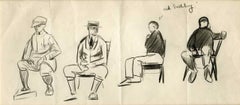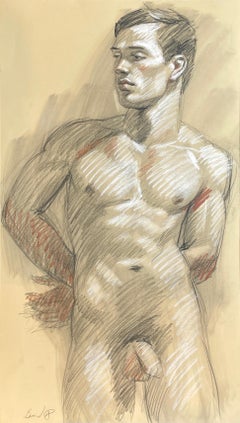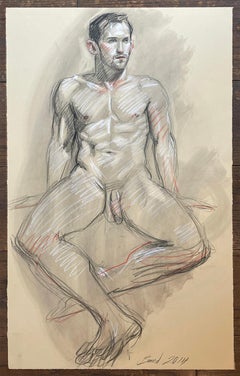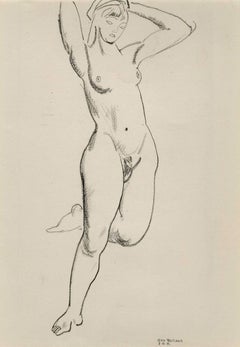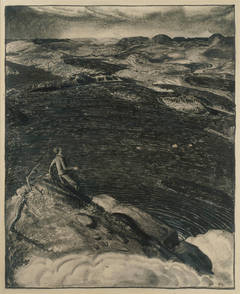George Wesley Bellows Drawings and Watercolor Paintings
American, 1882-1925
George Bellows, an American artist, was born in Columbus, Ohio in 1882, the only child of a successful building contractor from Sag Harbor, New York. He entered Ohio State University in 1901, where he played baseball and basketball and made drawings for college publications. He dropped out of college in 1904, went to New York, and studied under Robert Henri (American, 1865 – 1929) at the New York School of Art, where Edward Hopper (American, 1882 – 1967), Rockwell Kent (American, 1882 – 1971), and Guy Pène du Bois (American, 1884 – 1958) were his classmates. A superb technician who worked in a confident, painterly style, Bellows soon established himself as the most important realist of his generation. He created memorable images of club fights, street urchins swimming in the East River, and the Pennsylvania Station excavation site and garnered praise from both progressive and conservative critics.
In 1910 Bellows began teaching at the Art Students League and married Emma Story, by whom he had two daughters. After 1910 Bellows gradually abandoned the stark urban realism and dark palette characteristic of his early work and gravitated toward painting landscapes, seascapes, and portraits.
Bellows helped organize the Armory Show in 1913, in which five of his paintings and a number of drawings were included. That year he was elected a full member of the National Academy of Design. He had leftist political views and contributed illustrations to the Socialist publication The Masses from 1912 to 1917. Bellows began to make lithographs in 1916 and his exceptional talent engendered a revival of interest in the medium. He worked in Maine, in Carmel, California, and in Middletown, Rhode Island, and was a founding member of the Society of Independent Artists and a charter member of the Association of American Painters and Sculptors. In 1919 he taught at the Art Institute of Chicago.
Bellows, who never went to Europe, is regarded as a quintessential American artist whose vigorous style enabled him to explore a wide range of subjects from scenes of modern urban life to portraits of his daughters, to turbulent Maine seascapes. As an early biographer noted, Bellows “caught the brute force of the prizefighter, the ruggedness of the country pasture, the essence of childhood and recorded them appropriately not only for his own generation but for all time.”[1]
[1] [Frederick A. Sweet], George Bellows: Paintings, Drawings and Prints (Art Institute of Chicago, IL, 1946).
Robert Torchia September 29, 2016to
2
Overall Width
to
Overall Height
to
2
1
1
1
1
1
1
1
1
1
1
1
6
971
401
280
279
2
Artist: George Wesley Bellows
The Mouth of Honey
By George Wesley Bellows
Located in Fairlawn, OH
The Mouth of Honey
Lithographic crayon and mixed media on paper mounted to support paper
Initialed by the artist "GB" bottom center on image. (see photo)
Titled in pencil in bottom m...
Category
1920s Ashcan School George Wesley Bellows Drawings and Watercolor Paintings
Materials
Crayon
red ballboy or Studies for "Tennis Tournament"
By George Wesley Bellows
Located in Fairlawn, OH
Red Ballboy or Studies for "Tennis Tournament"
Crayon on paper, c. 1920
Unsigned
Condition: three vertical folds created by the artist to transport the drawing from the tennis match ...
Category
1910s Ashcan School George Wesley Bellows Drawings and Watercolor Paintings
Materials
Graphite
Related Items
MB 023 (Figurative Life Drawing of Handsome Male Nude by Mark Beard)
By Mark Beard
Located in Hudson, NY
Academic life drawing of male nude with charcoal and graphite by Mark Beard, "MB 023"
graphite, Conte crayon and charcoal on Arches paper
30.5 x 17.5 inches unframed
Signed, lower le...
Category
2010s Contemporary George Wesley Bellows Drawings and Watercolor Paintings
Materials
Conté, Charcoal, Archival Paper, Graphite
$1,650
H 30.5 in W 17.5 in
MB 702 (Contemporary Life Drawing of Male Nude by Mark Beard)
By Mark Beard
Located in Hudson, NY
MB 702 (Contemporary Life Drawing of Male Nude by Mark Beard)
graphite, Conte crayon and charcoal on Arches paper
30 x 19 inches unframed
Con...
Category
2010s Contemporary George Wesley Bellows Drawings and Watercolor Paintings
Materials
Conté, Charcoal, Archival Paper, Graphite
Self Portrait, of the Gentleman himself
By Francis Luis Mora
Located in New York, NY
A simply marvelous drawing - a self-portrait of the artist himself. It also reads as a very elegant and expressive line drawing of any gentleman - a hallmark depiction of a bon-vi...
Category
Early 20th Century American Realist George Wesley Bellows Drawings and Watercolor Paintings
Materials
Archival Paper, Graphite
MB 018 (Figurative Life Drawing of Handsome Male Nude by Mark Beard)
By Mark Beard
Located in Hudson, NY
Academic life drawing of male nude with charcoal and graphite by Mark Beard, "MB 018"
graphite, Conte crayon and charcoal on Arches paper
30 x 19 inches unframed
Signed, lower right
...
Category
2010s Contemporary George Wesley Bellows Drawings and Watercolor Paintings
Materials
Conté, Charcoal, Archival Paper, Graphite
$1,650
H 30 in W 19 in
A Pair of Framed Monkey Studies
By Alexander Oscar Levy
Located in Buffalo, NY
A pair of exquisite drawings by American Ashcan School artist Alexander Oscar Levy.
Category
1920s Ashcan School George Wesley Bellows Drawings and Watercolor Paintings
Materials
Archival Paper, Graphite
"View of Manhattan and the Woolworth Building" Joseph Pennell, New York Scene
By Joseph Pennell
Located in New York, NY
Joseph Pennell
View of Manhattan and the Woolworth Building, East River, circa 1915
Signed lower right
Watercolor with white bodycolor on paper
10 x 12 3/4 inches
Provenance
Arader ...
Category
1910s Ashcan School George Wesley Bellows Drawings and Watercolor Paintings
Materials
Paper, Watercolor
To England with Love, unique signed artist collage portrait & sculptural drawing
By Mark di Suvero
Located in New York, NY
Mark di Suvero
To England with Love, ca. 1992
Graphite and marker on collaged art paper
Signed and inscribed in marker
Unique
Measurements:
Matting:
12.25 inches vertical by 13
Artw...
Category
1990s Contemporary George Wesley Bellows Drawings and Watercolor Paintings
Materials
Permanent Marker, Graphite
Louis Bouché, (Standing Woman)
By Louis Bouché
Located in New York, NY
Louis Bouché was based in New York and taught at the Art Students League. The figure was an important subject in his oeuvre. An ink drawing on tan paper, ...
Category
Early 20th Century Ashcan School George Wesley Bellows Drawings and Watercolor Paintings
Materials
Ink
"Beach at Atlantic City, New Jersey" Amy Londoner, Ashcan School, Figurative
By Amy Londoner
Located in New York, NY
Amy Londoner
Beach at Atlantic City, circa 1922
Signed lower right
Pastel on paper
Sight 23 x 18 inches
Amy Londoner (April 12, 1875 – 1951) was an American painter who exhibited at the 1913 Armory Show. One of the first students of the Henri School of Art in 1909. Prior to the Armory Show of 1913, Amy Londoner and her classmates studied with "Ashcan" painter Robert Henri at the Henri School of Art in New York, N.Y. One notable oil painting, 'The Vase', was painted by both Henri and Londoner.
Londoner was born in Lexington, Missouri on April 12, 1875. Her parents were Moses and Rebecca Londoner, who moved to Leadville, Colorado, by 1880. In 1899, Amy took responsibility for her father who had come to Los Angeles from Leadville and had mental issues. By 1900, Amy was living with her parents and sister, Blanche, in the vicinity of Leadville, Denver, Colorado. While little was written about her early life, Denver City directories indicated that nineteenth-century members of the family were merchants, with family ties to New York, N.Y. The family had a male servant. Londoner traveled with her mother to England in 1907 then shortly later, both returned to New York in 1909. Londoner was 34 years old at the time, and, according to standards of the day, should have married and raised a family long before. Instead, she enrolled as one of the first students at the Henri School of Art in 1909.
At the Henri School, Londoner established friendships with Carl Sprinchorn (1887-1971), a young Swedish immigrant, and Edith Reynolds (1883-1964), daughter of wealthy industrialist family from Wilkes-Barre, PA. Londoner's correspondence, which often included references to Blanche, listed the sisters' primary address as the Hotel Endicott at 81st Street and Columbus Avenue, NYC. Other correspondence also reached Londoner in the city via Mrs. Theodore Bernstein at 252 West 74th Street; 102 West 73rd Street; and the Independent School of Art at 1947 Broadway. In 1911, Londoner vacationed at the Hotel Trexler in Atlantic City, NJ. As indicated by an undated photograph, Londoner also spent time with Edith Reynolds and Robert Henri at 'The Pines', the Reynolds family estate in Bear Creek, PA.
Through her connections with the Henri School, Londoner entered progressive social and professional circles. Henri's admonition, phrased in the vocabulary of his historical time period, that one must become a "man" first and an artist second, attracted both male and female students to classes where development of unique personal styles, tailored to convey individual insights and experiences, was prized above the mastery of standardized, technical skill. Far from being dilettantes, women students at the Henri School were daring individuals willing to challenge tradition. As noted by former student Helen Appleton Read, "it was a mark of defiance,to join the radical Henri group."
As Henri offered educational alternatives for women artists, he initiated exhibition opportunities for them as well. Troubled by the exclusion of work by younger artists from annual exhibitions at the National Academy of Design, Henri was instrumental in organizing the no-jury, no-prize Exhibition of Independent Artists in 1910. About half of the 103 artists included in the exhibition were or had been Henri students, while twenty of the twenty-six women exhibiting had studied with Henri. Among the exhibition's 631 pieces, nine were by Amy Londoner, including the notorious 'Lady with a Headache'. Similarly, fourteen of Henri's women students exhibited in the groundbreaking Armory Show of 1913, forming about eight percent of the American exhibitors and one-third of American women exhibitors. Of the nine documented works submitted by Londoner, five were rejected, while four pastels of Atlantic City beach scenes, including 'The Beach Umbrellas' now in the Remington Collection, were displayed.
Following Henri's example, Londoner served as an art instructor for younger students at the Modern School, whose only requirement was to genuinely draw what they pleased. The work of dancer Isadora Duncan, another artist devoted to the ideals of a liberal education, was also lauded by the Modern School. Henri, who long admired Duncan and invited members of her troupe to model for his classes, wrote an appreciation of her for the Modern School journal in 1915. She was also the subject of Londoner's pastel Isadora Duncan and the Children: Praise Ye the Lord with Dance. In 1914, Londoner traveled to France to spend summer abroad, living at 99 rue Notre Dames des Champs, Paris, France. As the tenets of European modernism spread throughout the United States, Londoner showed regularly at venues which a new generation of artists considered increasingly passe, including the annual Society of Independent Artists' exhibitions between 1918 and 1934, and the Salons of America exhibition in 1922. Londoner also exhibited at the Morton Gallery, Opportunity Gallery, Leonard Clayton Gallery and Brownell-Lambertson Galleries in NYC. Her painting of a 'Blond Girl' was one of two works included in the College Art Associations Traveling Exhibition of 1929, which toured colleges across the country to broad acclaim.
Londoner later in life suffered from illnesses then suffered a stroke which resulted in medical bills significantly mounting over the years that her old friends from the Henri School, including Carl Sprinchorn, Florence Dreyfous, Florence Barley, and Josephine Nivison Hopper, scrambled to raise funds and find suitable long-term care facilities for Londoner. Londoner later joined Reynolds in Bear Creek, PA. Always known for her keen wit, Londoner retained her humor and concern for her works even during her illness, noting that "if anything happens to the Endicott, I guess they will just throw them out." Sprinchorn and Reynolds, however, did not allow this to happen. In 1960, Londoner's paintings 'Amsterdam Avenue at 74th Street' and 'The Builders' were loaned by Reynolds to a show commemorating the Fiftieth Anniversary of the Exhibition of Independent Artists in 1910, presented at the Delaware Art Center, Wilmington, DE. In the late 80's, Francis William Remington, 'Bill Remington', of Bear Creek Village PA, along with his neighbor and artist Frances Anstett Brennan, both had profound admiration for Amy Londoner's art work and accomplishments as a woman who played a significant role in the Ashcan movement. Remington acquired a significant number of Londoner's artwork along with Frances Anstett Brenan that later was part of an exhibition of Londoner's artwork in April 15 of 2007, at the Hope Horn...
Category
1920s Ashcan School George Wesley Bellows Drawings and Watercolor Paintings
Materials
Paper, Pastel
$3,750
H 29.5 in W 24.5 in
Battle Scene, Spanish American War
By Francis Luis Mora
Located in New York, NY
Francis Luis Mora was considered one of America's finest "sketchers". A collection of his Sketchbooks are at the Smithsonian and this work came out of one in the early 1990's from t...
Category
1890s Ashcan School George Wesley Bellows Drawings and Watercolor Paintings
Materials
Graphite
$1,040 Sale Price
20% Off
H 13 in W 15.5 in D 2 in
Driving the Tee
By Leland Gustavson
Located in Fort Washington, PA
Medium: Watercolor over Graphite on Thick Paper
Signature: Unsigned
Gustavson was an excellent golfer himself and illustrated the book How To Play Your Best Golf by Tommy Armour in ...
Category
1960s George Wesley Bellows Drawings and Watercolor Paintings
Materials
Paper, Watercolor, Graphite
Children at Play, 1915, Ashcan School, New York, American, Park, Pastel on Paper
By Theresa Bernstein
Located in Wiscasset, ME
Born in Philadelphia in 1890, Theresa Bernstein showed early talent and interest in art. At the age of seventeen, she won a Board of Education scholarship to attend the Philadelphia ...
Category
1950s Ashcan School George Wesley Bellows Drawings and Watercolor Paintings
Materials
Paper, Pastel
$9,500
H 19.31 in W 22.38 in
Previously Available Items
Standing Female Nude
By George Wesley Bellows
Located in Fairlawn, OH
Standing Female Nude
Graphite on wove paper, c. 1915
Signed by the artist's daughter, Jean Bellows Booth (JBB) (see photo)
Provenance:
Estate of the artist
H. V. Allison Galleries (#94 on partial label), agent for Bellows Trust
Ronald Sloter, Columbus, OH, noted collector
Columbus College of Art and Design
Biography
George Wesley Bellows grew up in Columbus, Ohio, the son of a devout and solidly Midwestern building contractor, and a mother who hoped that her son would become a Methodist Bishop. He always felt deeply ambivalent about his father, noting at the time of his death that, "He was a wonderfully fine man, yet being fifty-five when I appeared, his point of view, his character even, belonged to so remote a past that I look upon many of his ideas to this day with amazement and sorrow."
Teased as a sissy by his classmates, George Bellows quickly learned to defend himself with his fists, and compensated for his gangling awkwardness by becoming an outstanding athlete, particularly in baseball. His love of drawing was kindled early since he was forbidden to play outside on Sundays but allowed to draw while his mother read aloud from the Bible.
At Ohio State University, George Bellows proved a spirited extrovert, excelling in baseball as well as in the new sport of basketball, singing in theatricals, and producing drawings of Gibson-like girls for the university's magazine. Bellows's athletic prowess almost diverted him from a career in art, but in 1904 he decided to turn down a professional baseball contact and move to New York City to study painting.
The sprawling, teaming city of New York was a revelation to him after the neat lawns and tidy homes of Columbus. There he quickly fell under the spell of the charismatic teacher Robert Henri, who introduced him to Shaw, Ibsen and socialism, and inspired him to shift from drawing Gibson Girls to painting the life of the streets. Bellows was still a relative newcomer to New York when Henri and his followers staged their famous exhibition of "The Eight" at the Macbeth Gallery, and consequently he was not included. But in spirit his work belongs with that display - perhaps someday Henri’s group will be rechristened "The Nine" to pay tribute to the fact that George Bellows was the painter whose work best expresses the goals of the group.
In 1906 Bellows painted his first masterpiece, "The Cross-Eyed Boy." He followed with several other equally memorable likenesses of street urchins, and then expanded his vision with a series of masterful urban scenes that record such subjects as boys swimming...
Category
1920s Ashcan School George Wesley Bellows Drawings and Watercolor Paintings
Materials
Graphite
Top I' the World
By George Wesley Bellows
Located in Fairlawn, OH
Signed by the artist lower right "G.B."
Preliminary drawing for the frontispiece illustration of The Wind Bloweth by Donn Byrne
Exhibited:
Gallery of Modern Art, 1966
A C...
Category
1920s George Wesley Bellows Drawings and Watercolor Paintings
Materials
India Ink, Oil Crayon
The Return to Life
By George Wesley Bellows
Located in Fairlawn, OH
Signed lower right by the artist's daughter Jean Bellows Booth (J.B.B.)
Preliminary drawing for the lithograph "The Return to Life" from the series "Men Like Gods."
Sister drawing in the Wiggin Collection, Boston Public Library.
Provenance:
Bellows Trust # ---
H.V. Allison & Co, New York, NY
R.H. Love Galleries, Chicago, IL
Thomas French Fine Art
Collection Arthur A. Anderson
Exhibition:
Greenville County Art Museum, George Bellows: Drawings (Greenville, SC: 1991).
R.H. Love Galleries, George Bellows: Drawings (Chicago, IL, 1992). (label)
On loan to the Samuel Dorsky Museum of Art, New Paultz, NY, 2006-2008
Sketch of man...
Category
1920s George Wesley Bellows Drawings and Watercolor Paintings
Materials
Crayon
Mans Hand (Handss of the Artist)
By George Wesley Bellows
Located in Fairlawn, OH
Signed lower right "Geo. Bellows J.B.B."
A study of 4 hands, presumably the artists.
Category
George Wesley Bellows Drawings and Watercolor Paintings
George Wesley Bellows drawings and watercolor paintings for sale on 1stDibs.
Find a wide variety of authentic George Wesley Bellows drawings and watercolor paintings available for sale on 1stDibs. You can also browse by medium to find art by George Wesley Bellows in graphite, pencil, crayon and more. Not every interior allows for large George Wesley Bellows drawings and watercolor paintings, so small editions measuring 9 inches across are available. Customers who are interested in this artist might also find the work of and Norman Barr. George Wesley Bellows drawings and watercolor paintings prices can differ depending upon medium, time period and other attributes. On 1stDibs, the price for these items starts at $3,500 and tops out at $55,000, while the average work can sell for $4,500.
Questions About George Wesley Bellows Drawings and Watercolor Paintings
- 1stDibs ExpertApril 5, 2022Cliff Dwellers by George Bellows is a painting created in 1913 that’s meant to depict the explosive population growth that New York City was experiencing at the time. Specifically, the painting is of a hot summer’s day in New York City’s Lower East Side. On 1stDibs, find a variety of original artwork from top artists.
- 1stDibs ExpertApril 5, 2022George Bellows created paintings that focussed on realism. His oil paintings mixed urban studies with social and political themes, mainly centered around New York City. On 1stDibs, you can shop a selection of George Bellow’s pieces from some of the world’s top art dealers from the comfort of your home.
